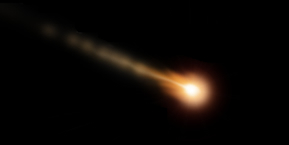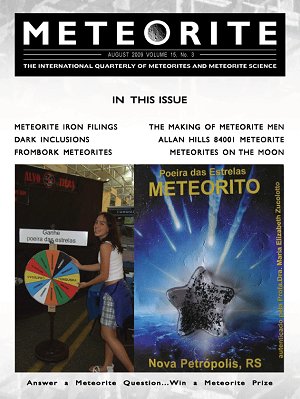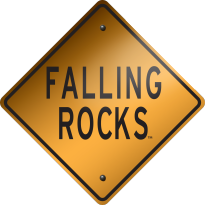|
TEMPORARY CUSTODIANS
Cosmic Perspective
Our respective fates here on planet Earth are all inevitable. Sooner or later - and whether we like it or not - each of us will eventually assume room temperature. Seemingly against all odds, we are born, we experience a few decades on the big ball (if we're lucky), then we die. Our atoms are once again stirred back into the terrestrial soup, and that's about all she wrote.
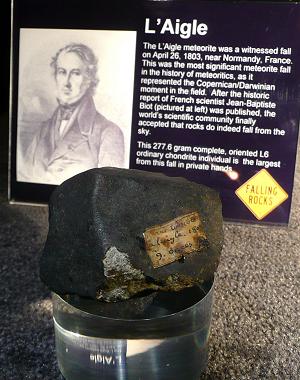
A 277.6 gram complete individual in the author's collection, shown here with a custom plaque used in both public and private exhibition.
|
Those of us fortunate enough to experience these few decades here on the big ball from a seat within the international meteorite community's theater see things from a rather unique perspective, as these objects of our fascination are, for the most part, older than the big ball itself. For more than 4.5 billion years, they have roamed in the vastness of outer space, entering our atmosphere by mere happenstance only very recently in relative terms. If those 4.5 billion years flashed before your eyes in a high speed movie at the rate of one year per second, it would take you almost 15 decades - almost certainly more than any of us will have - to watch it.
Just 206 years ago - about 3 ½ minutes from the end of this hypothetical 150-year-long movie - the world's scientific community was finally convinced by Jean-Baptiste Biot's landmark report of the L'Aigle witnessed fall that rocks do, indeed, fall from the sky. The subject of meteorites, in terms of human comprehension, is but a single fertilized cell in the womb which has yet to divide even once. As humankind's reach into the vastness of space continues to expand like the universe itself, the international community of meteorite collectors will no doubt grow by orders of magnitude.
Unbroken Chain
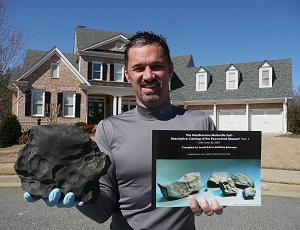
The author with the Bassikounou 6120 gram main mass in his collection along with Dr. Svend Buhl's magnificent, comprehensive report of this October 16, 2006, witnessed fall.
|
There was a time when private collectors were considered taboo by many. Meteorites were institutional provenance, and that was the way it was supposed to be. But thanks to a few historic and present day figures, access to and enthusiasm for these incredible objects has skyrocketed in the general public. As a result, recovery incentives have increased, and, in spite of private collectors' appetites, more material has made its way into the hands of scientific and exhibition institutions along the way. Simply put, as the recovery incentive has advanced we have learned more and the general public has seen more (when museums actually exhibit their specimens, anyway).
The private collectors of today, whether consciously or not, are establishing precedent for future generations. How we curate and exhibit (whether privately or in public) our collections - and how we use them to help share our knowledge with the next generation so they, too, might appreciate them and perhaps directly contribute to an increase humankind's understanding of the universe - is important. We are under a microscope. Now more than ever, international laws threaten recovery levels by virtue of the essential extrication of reasonable recovery incentives, and concern for the advancing trend of such legislation is merited. There is no reason why the private collector community should not be considered among the most credible custodians of rocks from space, but this means that no stones should be left unturned in maximizing the preservation and ownership succession of these celestial visitors for the benefit of future generations yet to come.
We are but temporary custodians of our collections in what will hopefully be a long line of such custodians in the decades, centuries and millennia to come. Here in the United States we say that "a chain is as strong as its weakest link." This is a good reminder, and the good news is that, as individual custodians, there are some things we can do to better insure that this chain of custodians will be unbroken while still enjoying this fantastic hobby along the way. Not every collector shares these sentiments, of course, but it is those who do that will pave the road ahead.
Simple Steps
Contemplating the macabre, such as one's own end, is not the most pleasant exercise - particularly when considering an untimely scenario. But just think it through for a moment. There are obviously far greater immediate priorities than meteorites in such an event. Yet, when viewing things across a larger span of time, it can be comforting to know that provisions for the transfer of your cosmic possessions have been established which can clearly be followed by your survivors.
Below are some simple steps you can take to better provide for a successful transition of your meteorite collection when that time comes:
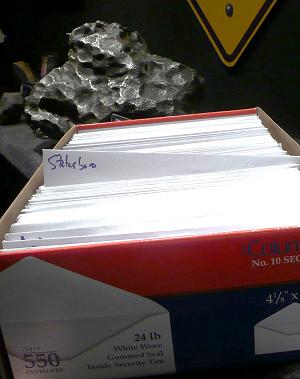
Ideally housed in a fireproof safe, a simple box of envelopes from an office supply store can handle a substantial amount of the filing requirements associated with a collection.
|
- Properly catalog your meteorite specimens. While is it possible to do this via your own website (with public and private access elements to it, if necessary), a simple spreadsheet platform would suffice. Columns should at least include the formal meteorite name, its location, its classification, the date it fell or was found (and specifically whether it is a fall or a find), its weight, total recovered weight for the location, a specimen description (i.e. "end part slice," "complete individual," "end section," etc), the date of acquisition, the price paid for it, provenance (everything you know), your collection number and general comments. This information would also be invaluable in the event you decided to sell your collection at some point (and would actually add value to the collection itself); the tax exposures alone easily justify the effort. In storage or on display, individual specimens should be accompanied by a display plaque or label, or perhaps marked themselves (the latter should be carefully researched in advance).
- Organize a filing system for all ancillary materials (collection labels, photographs, artifacts, letters, etc) related to each of your meteorites. In most cases it is not necessary to install a full-sized metal office cabinet for this purpose. A box of envelopes from an office supply store works well (more envelopes than there are locations in your collection, of course); leave the empty envelopes in the box and arrange alphabetically (labeling the envelope's exterior) from one side, say, the named locations in your collection and from the other side, say, NWAs in ascending numerical order (there are many ways to organize this filing system, of course, and multiple boxes could be used). I also use large, transparent plastic envelopes with a string clasp to store the ancillary materials related to certain specimens in my collection which are either too large or numerous for a standard envelope to accommodate.
- Photograph each specimen in your collection. The images could be posted on your own website or on IMCA's Encyclopedia of Meteorites (see http://www.encyclopedia-of-meteorites.com), to name a couple of examples, but at a minimum the photos need to be taken and stored independently from your collection. If you don't use a website, it is also important to include an image of the specimen in each location file. Meteorites are somewhere between cost prohibitive and virtually impossible to insure, and a photographic trail - be it on the web or in printed form - is the best failsafe in the event specimens are, for example, stolen.
Steps 1 - 3 should really be done without consideration of the eventual transfer of your collection. This facilitates things like organization, trading and general sanity. It is also advisable to keep either the originals or copies of these materials in a fireproof safe, safe deposit box or just an alternate location; protecting them with plastic and proximity from potential water damage is also advisable. I have a fellow-collector friend who has done none of these first three steps. While it is truly remarkable to see him verbally present the catalog that resides in his brain while presenting his inventory, it is also hard to see such a terrific collection sitting on the precipice since it would be impossible to correctly identify a significant portion of it in his absence.
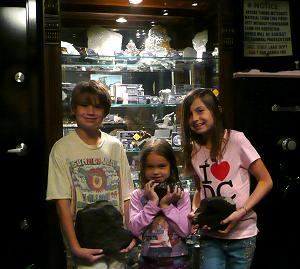
Zach, Maddie and Katy, with Chergach, Sikhote-Alin and Mbale, respectively. Perhaps among the next generation of temporary custodians to watch over such specimens?
|
- Storing multiple copies of a digital video of you, "presenting" the contents of your meteorite collection, might be the best way to accomplish this objective, and so much more information can be captured through audio commentary than with just the still photos.
- Account for your meteorite collection in your will (and if you don't have a will, there's no better time than the present to sort that out). Even if you were to survive another 100 years, in the absence of a will there is a certain level of stress associated with the possession of a meteorite collection. And dealing with these issues in advance will alleviate much of that concern. Consider this: if, god of your choice forbid, you were to die in a tragic car accident tomorrow, what would happen to the meteorites in your collection? Would they wind up in a "my-father-passed-away-and-had-these-rocks-but-I-don't-know-what-they-are" eBay auction? Is their value substantial enough that you would want your heirs to receive it in full? Might your collection sit in storage long enough that it may, for all intents and purposes, be lost forever? I understand that in at least some cases it is possible to accomplish this by simply writing an "Upon my death..." letter, outlining your clear instructions and having it signed by a witness in addition to yourself. But, to be certain, it would probably be best to review such a plan with an attorney.
- Concurrent with the development of your will (or the writing of a letter as suggested in #4), appoint trustees exclusively for the purpose of managing or transferring your collection in the event of your untimely or naturally-occurring departure. In most cases, collectors have no family members knowledgeable enough about their collection, or even meteorites in general, to effectively handle this task. Provide them with necessary information, such as your catalog, specimen locations (including those on loan for exhibit, etc), website user name and password, safe combination and the like. Also include specific instructions for the transfer of your collection to your heirs, the liquidation of it (hopefully with some consideration for moving the specimens into meteorite-savvy hands) or perhaps the donation and transfer of it to an institution.
- Enjoy everything about your collection during your few-decades-long ride here on the big ball!
Lesson Learned
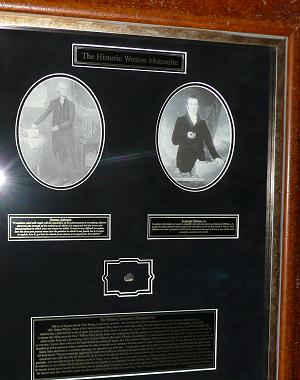
Taking it to an extreme, this specimen from the author's collection has been framed along with plaques telling the story of the historic Weston fall along with portraits of Thomas Jefferson and Benjamin Silliman.
|
Early on the morning of December 14, 1807, a brilliant fireball approximately two-thirds the size of the moon was witnessed in Vermont and Massachusetts as it progressed in a southern direction en route to Fairfield County, Connecticut. Three loud detonations were heard in the town of Weston, and fresh H4 ordinary chondrite specimens were recovered in at least six different locations, totaling some 150 kilograms of material.
Today, only about 25 kilograms of this meteorite can be accounted for. This was the first documented fall witnessed by European settlers and their descendants in North America, and it came almost immediately on the heels of the Darwinian/Copernican moment that L'Aigle represented. Where did all of it go? It's certainly still here with us on the big ball - somewhere - but more than likely none of it will ever be reclaimed by the international meteorite community again. Without a doubt, the generations of hands through which it would have had to pass were chains with weak links. The defining moments which came with the passing of specimen owners over time were likely not met with preparation, so the vast majority of the irreplaceable Weston meteorite is now lost forever.
We might as well learn from the mistakes of others, as there is simply not enough time to make all of them ourselves, anyway!
Article by Dave Gheesling
The full version of this article was published in the
August 2009 issue of METEORITE! magazine.
|
